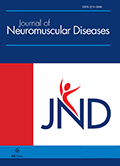Authors: Martí, Yasmina | Aponte Ribero, Valerie | Batson, Sarah | Mitchell, Stephen | Gorni, Ksenija | Gusset, Nicole | Oskoui, Maryam | Servais, Laurent | Deconinck, Nicolas | McGrattan, Katlyn Elizabeth | Mercuri, Eugenio | Sutherland, C. Simone
Article Type:
Systematic Review
Abstract:
Background: Respiratory and bulbar dysfunctions (including swallowing, feeding, and speech functions) are key symptoms of spinal muscular atrophy (SMA), especially in its most severe forms. Demonstrating the long-term efficacy of disease-modifying therapies (DMTs) necessitates an understanding of SMA natural history. Objective: This study summarizes published natural history data on respiratory, swallowing, feeding, and speech functions in patients with SMA not receiving DMTs. Methods: Electronic databases (Embase, MEDLINE, and Evidence-Based Medicine Reviews) were searched from database inception to June 27, 2022, for studies reporting data on respiratory and/or bulbar function outcomes in Types 1–3 SMA. Data were
…extracted into a predefined template and a descriptive summary of these data was provided. Results: Ninety-one publications were included: 43 reported data on respiratory, swallowing, feeding, and/or speech function outcomes. Data highlighted early loss of respiratory function for patients with Type 1 SMA, with ventilatory support typically required by 12 months of age. Patients with Type 2 or 3 SMA were at risk of losing respiratory function over time, with ventilatory support initiated between the first and fifth decades of life. Swallowing and feeding difficulties, including choking, chewing problems, and aspiration, were reported in patients across the SMA spectrum. Swallowing and feeding difficulties, and a need for non-oral nutritional support, were reported before 1 year of age in Type 1 SMA, and before 10 years of age in Type 2 SMA. Limited data relating to other bulbar functions were collated. Conclusions: Natural history data demonstrate that untreated patients with SMA experience respiratory and bulbar function deterioration, with a more rapid decline associated with greater disease severity. This study provides a comprehensive repository of natural history data on bulbar function in SMA, and it highlights that consistent assessment of outcomes in this area is necessary to benefit understanding and approval of new treatments.
Show more
Keywords: Spinal muscular atrophy, neuromuscular diseases, rare diseases, natural history, respiratory function tests, speech, deglutition, review
DOI: 10.3233/JND-230248
Citation: Journal of Neuromuscular Diseases,
vol. 11, no. 5, pp. 889-904, 2024





